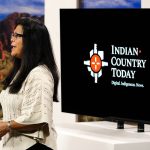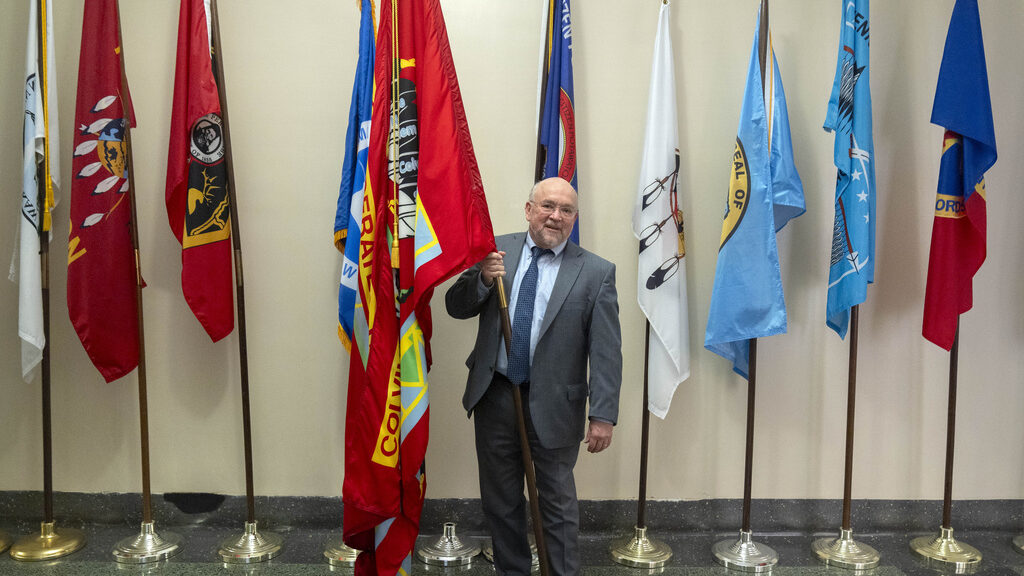Indigenous news outlets, nonprofits drive deeper coverage
Jan 11, 2022, 11:50 AM | Updated: 3:58 pm

CORRECTS TITLE TO EDITOR AT LARGE - Indian Country Today editor at large Mark Trahant speaks during a news broadcast taping, as video production editor Quindrea Yazzie, left, operates the teleprompter Friday, Sept. 10, 2021, in Phoenix. Native American communities have seen more robust news coverage in recent years, in part because of an increase in Indigenous affairs reporting positions at U.S. newsrooms and financial support from foundations. (AP Photo/Ross D. Franklin)
(AP Photo/Ross D. Franklin)
PHOENIX (AP) — Kiowa tribal member Tristan Ahtone remembers just getting started in journalism over a decade ago and pitching ideas on Indigenous topics. His bosses would say things like: “We ran a Native story earlier this year. Do we need another one?”
Thankfully, he said, times have changed.
“Nowadays there’s not enough content to fill demand, which is fantastic,” said Ahtone, a former longtime Native American Journalists Association board member and current editor at large at nonprofit media outlet Grist.
Native American communities have seen more robust news coverage in recent years, in part because of an increase in Indigenous affairs reporting positions at U.S. newsrooms and financial support from foundations.
Journalism-focused philanthropy quadrupled from 2009 to 2019 as traditional newspaper revenue shrank, according to a Media Impact Funders report. At the same time, an increasingly diverse population and a renewed focus on social injustice have commanded greater media attention.
Nonprofit news outlets, which have multiplied across the U.S., are among those leading the way.
Colorado-based High Country News created an Indigenous affairs desk in 2017 that has published dozens of stories from journalists, authors and experts across Indian Country.
Other non-Native outlets followed with new beats and staff.
National service program Report for America provides funding to many outlets, including The Associated Press, and is helping finance temporary Indigenous affairs reporting positions at 10 U.S. newsrooms. They’re part of a corps of journalists the organization established in recent years to bolster coverage of underserved communities.
The program works to address some of the unique challenges of covering Indian Country, where many reservations are isolated or have historically poor relations with the press after long being misrepresented or ignored.
“We’re trying to rebuild trust that’s been lost in the past 20 to 30 years,” said Teri Hayt, Report for America’s deputy director of corps excellence and manager of its Mountain West region. “It’s about building it back and putting talented, emerging journalists into newsrooms.”
Some of the news organizations it partners with have never had a dedicated Native American affairs beat. Several corps members identify as Indigenous. They include Frank Vaisvilas, a descendant of the Yaqui Tribe of Mexico who serves as a Native American affairs reporter for the USA Today network based at the Green Bay Press-Gazette in Wisconsin. He started covering the state’s 12 tribal nations in 2020.
“There’s a lot of education that’s happening with this beat,” including helping people understand the nuances of sovereign nations, he said.
Vaisvilas has reported on a land dispute involving the Oneida Nation and the Green Bay area village of Hobart, the harassment of Ojibwe spearfishers over treaty rights, and the suspension of tribal officials by the Menominee legislature. His stories include discussions of tribal laws, jurisdiction, gambling, languages and a host of other issues, and he produces a First Nations Wisconsin newsletter.
Historically, he said, major news outlets have tended to rely on tropes like poverty and addiction when covering Indian Country. Vaisvilas said he works to “seek the truth that’s out there and not just feed stereotypes.”
The increased coverage comes as America’s demographics change. According to the latest census, the growth in the number of people who identified as multiracial rose from under 3% to more than 10% of the U.S. population from 2010 to 2020. Of those, about 6.7 million people identified as non-Hispanic, American Indian and Alaska Native alone or in combination with another race group, representing 2% of the population.
Despite the growing interest, advocates say much more needs to happen.
Many mainstream news organizations still lack Indigenous affairs reporting positions, including some of the country’s largest.
And there have been missteps. In 2020, CNN received backlash for an elections graphic that displayed returns by race as white, Latino, Black, Asian and “something else” — a label that outraged many Native Americans.
The Washington Post also came under fire for reporting related to the Washington NFL team’s now-abandoned Native-themed mascot. In 2019, the Native American Journalists Association slammed the newspaper for its “recurring problem” of relying on flawed data from self-identified Native Americans who said they weren’t offended by the name.
Last year, Indigenous groups — and Interior Secretary Deb Haaland — flagged the outsized media coverage surrounding the disappearance and death of 22-year-old Gabby Petito, saying more attention must be paid to the longstanding epidemic of missing and murdered Native American women.
Ahtone also pointed out that while a big focus lately has been on investing in local news, that discussion rarely extends to tribal media.
Jodi Rave Spotted Bear, executive director of the Indigenous Media Freedom Alliance, said grant opportunities have been the “light in the tunnel” for her organization and its publishing arm, digital news site Buffalo’s Fire.
Most tribal media organizations are funded by their tribes’ governments — very few of which have rules providing press protections.
“Freedom of information does not exist in the community where I live. The tribal government doesn’t have any open meetings,” said Spotted Bear, of the MHA Nation. “A lot of reservation communities are like that.”
The result, she said, is decisions made under a “cloak of secrecy,” including the allocation of sometimes massive amounts of money.
One key accomplishment of Phoenix-based news operation Indian Country Today has been independent ownership, coming out from under the umbrella of the National Congress of American Indians last year.
The Indigenous-led operation has a wider audience than ever after a 2018 relaunch and the start of a daily newscast. It broadcasts to more than two dozen stations in the U.S., Canada and Australia, and reaches another 800,000 unique users each month on its digital site.
Editor at large Mark Trahant, who is Shoshone-Bannock, cites a combination of donations, advertising, underwriting and foundations. Indian Country Today also has collaborated with the AP to reach more readers around the world, and recently began partnering with another nonprofit news outlet, Underscore.com, on coverage of the Pacific Northwest.
A number of ongoing efforts are aimed at bolstering the ranks of journalists of Indigenous descent and increasing the focus on Indian Country.
A 2019 American Society of News Editors survey showed less half of 1% of workers at U.S. newsrooms were Native American. However, the Native American Journalists Association said its membership has expanded significantly since then.
The organization trains students through various programs, including a fellowship that has helped place interns at NBC News, CBS News, USA Today and elsewhere. Last year, it started teaming with NPR on an Indigenous-centered digital workshop for early career professionals.
It also stresses the importance of having Native Americans represented in prominent journalism roles such as board members, publishers, senior editors and TV anchors.
Meanwhile, the Institute for Nonprofit News, which provides support for nonprofit news organizations, announced a new consortium covering rural America is kicking off with collaborations that include investigating economic issues in Indigenous communities.
The country has a lot to gain from greater coverage of first nations people, their cultures and languages, which often emphasize community over the individual, Vaisvilas said. He’s glad to be a part of that and strives to honor his elders and ancestors through his work.
“I feel a lot of weight sometimes to try to get it right, to try to get the reporting right and try to tell the story right,” he said. “A lot Indigenous people say, ‘We’re still here, that we never went anywhere. We just have been ignored for so long.’ So I just hope that news reporting can help put a stop to that.”
___
Oyan, an Associated Press editor based in Phoenix, served as managing editor of Indian Country Today in 2020 as part of a collaboration between the organization and AP.
___
This version has been updated to remove a reference to an International Women’s Media Foundation initiative that has been canceled.
Copyright © The Associated Press. All rights reserved. This material may not be published, broadcast, rewritten or redistributed.


















